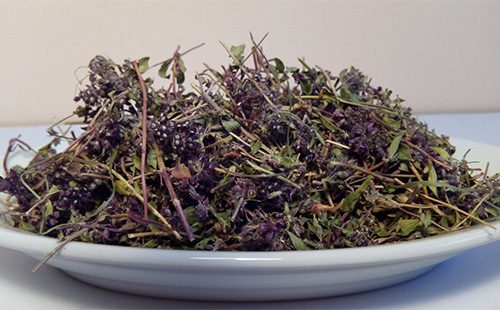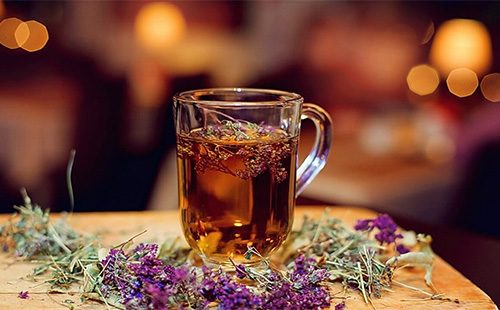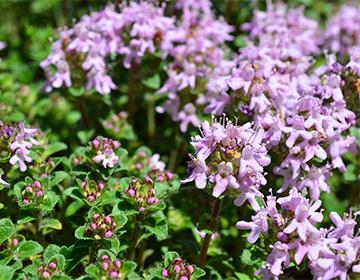The content of the article
Thyme grows on well-drained sandy soils. It is considered drought and frost resistant. It occurs everywhere in the steppe zone, fills with light forest edges, the slopes of beams and meadows. Landed on personal plots. Actively grown indoors in pots. It is used in cooking as a spice, as well as in cosmetology and the perfume industry.
In official medicine, creeping thyme is used in the form of teas, extracts from raw materials and finished dosage forms with plant extract.
Botanical characteristic of thyme
Botanists distinguish a separate genus Thyme from the Yasnotkovs. It includes over 200 species, most of which are represented in the wild nature of Russia. The synonym thyme is used relative to creeping thyme, although common thyme also has medicinal properties. You can recognize a plant in the steppe based on its morphological characteristics.
- General form. Perennial shrub plant. It rarely exceeds 20 cm in height. It exudes a specific aroma that can be easily felt even at a great distance.
- The stalks. Numerous stems depart from a single rhizome. Some of them are creeping, creeping along the ground, rooted in accessory roots. The shape is cylindrical. The lower part becomes woody, and the upper remains thin and green. Stems often acquire a reddish tint.
- Leaves. Located opposite the stems. A leaf plate of elongated elliptical shape, deep green in color. Numerous glands secreting essential oil are visible on the surface. Along the edge, the leaves are covered with a large number of light and thin cilia.
- Flowers. Thyme blooms from May to August (depending on climatic conditions). Irregular flowers of pale pink or pink-violet color are collected on the tops of the stems in inflorescences-heads.
- Fruit. Formed after flowering - in August-September. They are represented by small nuts of brown color, elongated in a round shape, 5-6 mm in length.
Harvesting of raw materials
You can harvest thyme for medicinal purposes in the wild and at home. In this case, several rules should be observed.
- Collection. Thyme cannot be torn out - this is fraught with death of thickets. Collect only the upper parts of the stems with scissors, trying not to damage the lignified lower parts.They begin harvesting during the period of mass flowering, which is different for each region. It is necessary to cut off the inflorescences as soon as possible after their opening. As it blooms, the plant loses its essential oil, which means beneficial properties.
- Training. Before drying, the collected shoots are sorted out for impurities, insects are shaken out, discolored inflorescences, brown parts are removed.
- Drying. It is preferable to dry thyme in vivo, however quickly. For this, warm attic rooms or canopies with a metal roof are suitable. The stems are laid out on a pallet very loosened, they are often ted for even drying. When using an oven or dryer, temperatures of up to 35 ° C should be adhered to.
- Storage. Before folding thyme in a container for storage, it is cleaned of rough parts. It is enough to grind the stems with your palms, and all thin, completely dry fragments will be crushed and fall off. Coarse and leathery - discarded. Store raw materials in a tight container, preventing the loss of essential oil.
Composition
Culture has a number of healing properties. Most of them are manifested due to the content of essential oil in the grass. This product consists of aromatic alcohols - volatile compounds with a specific odor. The main substances in the composition of thyme oil are carvacrol and thymol. They exhibit antibacterial, antiviral, antimycotic effects, contribute to the elimination of local and generalized infectious lesions of the body. They also exhibit mild sedative, antispasmodic, analgesic and expectorant effects.
Other beneficial compounds in the composition of the herb:
- tannins - possess astringent, anti-inflammatory, hemostatic and regenerative actions;
- bitterness - exhibit antiparasitic effect, improve the functioning of the endocrine glands, normalize appetite;
- gums - cleanse the body of toxins, contribute to the normalization of intestinal microflora;
- flavonoids- substances with a vasoprotective effect, the ability to strengthen vascular walls, normalize their permeability, activate immunity.
Almost all the substances in the thyme are active antioxidants - they protect the body from adverse factors that provoke premature aging. Thanks to minerals, the plant helps to cleanse the blood, normalizes its biochemical composition and viscosity. The culture contains a lot of selenium, zinc and molybdenum - prevents the deficiency of these compounds.
Grass has a positive effect on metabolic processes. The action is due to the content of organic acids:
- Coffee
- chlorogenic;
- ursolova;
- oleanic.
They normalize the work of the digestive tract, optimize the digestion process, improve motility, eliminate pathogenic microorganisms in the intestine.
Diseases for which it helps
Thyme is considered a universal soft-acting plant material, the use of which is useful for children, adults and the elderly.
Respiratory system
The main indication for thyme treatment is respiratory diseases. Grass is prescribed for:
- pharyngitis;
- laryngitis;
- pneumonia;
- bronchitis;
- whooping cough;
- asthma
- sinusitis;
- runny nose;
- nasal congestion.
Thyme optimizes the functioning of the ciliary epithelium of the bronchi, which helps to thin the sputum and remove it to the outside. Acting as an antispasmodic, it prevents coughing fits and facilitates the evacuation of sputum.
Gastrointestinal tract
The second area of application of creeping thyme is the treatment of the digestive tract. The plant improves the secretion of glands (with pancreatitis, low acidity), normalizes the condition of the mucous membranes (with gastritis, colitis), starts motility, optimizes the absorption of nutrients. The use of thyme preparations is indicated for:
- inflammation of the stomach and intestines;
- pain in the abdominal region;
- flatulence;
- diarrhea;
- helminthic infestations;
- dysbiosis;
- nausea

Nervous system
With sleep disturbances and excessive nervousness, thyme calms, acts as a sleeping pill. At the same time, the grass regulates blood pressure and evens out the heart rate. With depression, loss of strength and overwork, thyme tones, helps to concentrate and put in order thoughts.
Women's and men's health
In folk medicine, thyme is considered a “female” herb - it is treated with copious and painful periods, infertility, and gynecological diseases of an inflammatory nature. But grass is also good for men. It is taken as an anti-inflammatory and antispasmodic with prostatitis. As a source of selenium and molybdenum, thyme has a positive effect on spermatogenesis. With the help of the plant, increased sexual excitability is eliminated, erectile dysfunction of a neurogenic nature is treated.
Application features
Thyme is grown and harvested on an industrial scale to produce essential oil. The use of ether must be careful, in fact it is a plant concentrate. Internal intake is possible only on the recommendation of a phytotherapist. Outwardly used like this:
- bathtubs - add five to seven drops of oil to a full bath of moderately hot water;
- enrichment of cosmetics - introduce one drop of oil for every 5 g of cosmetic product or add a drop in a single portion immediately before application;
- in pure form- it is possible to spot on acne, inflamed abscess boils, herpes rashes.
Children and pregnant
In children and pregnant women, the use of thyme ether is contraindicated. Expectant mothers can only drink thyme tea (with flu, cough, SARS), but after consulting a doctor.
In young patients, it is generally undesirable to use the grass inside. Small deviations from the prescription can cause an overdose, provoke an allergy. But outdoor use is useful - as part of bathtubs. Bath procedures with a plant will save you from:
- allergic rashes;
- scrofula;
- coughing attacks;
- sleep disturbances.
Contraindications
Thyme is an essential oil raw material, so it can only be used after an allergy test. For this, ether is applied to the skin from the back of the wrist. If redness or swelling is absent - the plant can be used. Thyme cautious intake require such conditions:
- disorders in the thyroid gland;
- damage to the digestive system;
- mental disorders;
- hypertension;
- diabetes;
- tuberculosis.
In the presence of any chronic ailments, treatment with thyme should be agreed with the doctor.
Prescription Drugs
The most famous pharmaceutical preparation of thyme is Pertusin syrup. It is prescribed for any type of cough. Also in pharmacies you can buy packaged and loose plant materials.It is used for self-medication.
Tea
Features The tool is suitable as a complement to the treatment of colds, digestive disorders. Drink as a tonic and restorative drink.
Preparation and use
- A teaspoon of chopped herbs is poured with a glass of boiling water.
- The mixture is covered and left to infuse for ten minutes.
- After straining, honey is added to taste.
- Take up to three cups per day.
Water infusion
Features. Take orally against cough and sleep disturbances. You can also use externally - make compresses and lotions. The latter are useful for facial skin: they treat rashes, acne, and inflammatory processes.
Preparation and use
- A tablespoon of shredded grass is poured into a thermos.
- Pour the raw materials with a glass of boiling water.
- Close the thermos, leave the tool to insist for an hour.
- After straining, store in the refrigerator.
- Take a tablespoon up to four times a day.

Alcohol extractor hood
Features It can be used for bacterial and viral infections, as a sedative. And also to eliminate inflammatory processes in the treatment of gynecological and andrological ailments.
Preparation and use
- Three tablespoons of chopped thyme are poured into a container for infusion.
- Raw materials are poured into a glass of quality vodka.
- After ten days, the product is filtered, taken three times a day, 15 drops.
In folk medicine, thyme treats the initial forms of alcoholism. A person should drink a cool infusion of grass. After half an hour, the patient is offered alcohol. The attempt, as a rule, ends with an attack of vomiting. Repeated repetition of such "sessions" forms an aversion to a "glass". Experts say that the technique only works if the patient has a vomiting reflex and there is a desire to abandon the addiction.

